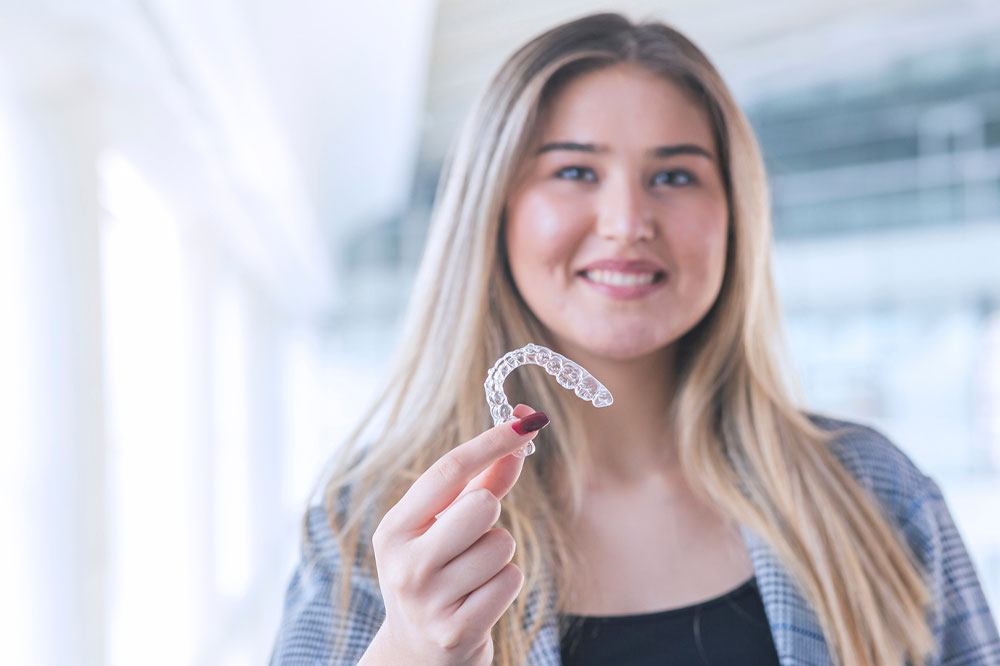Top 8 Clear Braces to Consider

Braces and aligners are often used by teenagers who wish to align their teeth and have the perfect smile. But their usage does not have to stop there. Adults can also use braces. Increasingly, adults have begun turning to clear braces as an alternative to metal ones to manage orthodontic issues, such as correcting crooked teeth. Keeping this in mind, we have listed some of the best options for clear braces to try today.
Best clear braces to consider
There are different types of braces to choose from. But one option that has risen to the top is clear braces. They are comfortable, affordable, and also incredibly convenient to wear. They help manage uncorrected misalignment and specific other dental issues without being noticeable. Read on to learn more about the best clear braces, their features, and prices:
Byte
Byte is one of the most popular clear aligner options out there that offers its customers a plethora of perks. Its best features include a free treatment guarantee, a free first set of retainers, complimentary teeth whitening, and daytime and nighttime-only options. Moreover, the braces are made of a BPA-free, medical-grade polymer film, testifying its quality. The product can cost $1,895 to $2,295, depending on the type and comfort level. However, note that the company does not have physical locations or offices, which may pose a problem.
SmileDirectClub
SmileDirectClub’s clear braces feature trademarked technology, such as Smart Sculpt™ and Comfort Sense™, that ensure precision and comfort throughout the treatment. The company offers its customers (those who wear the retainers regularly) a Lifetime Smile Guarantee™, through which one can claim their money back within 30 days if unsatisfied with the results or free aligner touchups during the treatment duration. Some other features that set the company apart are multiple convenient treatment options, a free in-person 3D scan, and help with dental insurance. SmileDirectClub braces may cost around $2,050 if users make a one-time payment.
AlignerCo
This company provides the best quality treatment at a budget-friendly price. But affordability is not its only selling point. AlignerCo also offers flexible financing options, a down payment option, nighttime aligners, and a free whitening kit as a part of several payment plans. If the aligners do not work, customers can either ask for a full refund for the cost of the impression kit or a reevaluation for new clear aligners. One can get AlignerCo braces for around $1,145.
Invisalign
Backed by more than two decades of experience, technology, and real-world results, Invisalign is among the best in the market. Some of the best features that set the company apart are its special programs for children between six and ten years, its ability to address a wide range of alignment and bite problems, and its custom-design clear braces. Invisalign’s products usually range from $3,400 to $7,100, and the treatment covers a period of 12 to 18 months. A dental practitioner or orthodontist oversees the treatment every step of the way to ensure satisfying results.
Smilelove
This company runs all its operations online and ensures patients receive their aligners at their doorstep via mail. As a part of the SmileLove package, one may receive a molding kit, retainers, custom clear braces, and a whitening kit. In most cases, patients might need 15 to 20 different aligners to be worn for two weeks each. The treatment is highly budget-friendly at around $1,895, which covers the entire cost. While Smilelove braces are not covered by insurance, one can use Health Savings Account (HSA) and Flexible Spending Account (FSA) plans to cut costs further.
SnapCorrect
One of the newest players in the industry, SnapCorrect operates entirely online, keeping its costs extremely low. The company mentions that it has one of the clearest braces available in the market. So, SnapCorrect might be the best pick for those wishing to buy near-invisible aligners. While the treatment to correct the teeth lasts for three to nine months, it might take longer if the degree of misalignment is high. The clear braces and treatment are available for $1,749, but one might have to pay an additional sum for custom aligners.
NewSmile
With NewSmile, patients do not need to visit dentists or orthodontists in person. Instead, the company offers virtual consultations through which dental experts answer patients’ questions. Customers get a complete refund if the orthodontists or dentists at NewSmile determine that the clear braces are unsuitable for the treatment needed. When one purchases removable aligners, the company offers a free teeth whitening kit and a free first set of retainers as part of the deal. However, one might have to pay for more retainers needed during the treatment. Moreover, NewSmile provides a 3D treatment preview on the app, which shows the patient their post-treatment smile! A comprehensive treatment package costs around $1,295.
Candid
Candid works exclusively with orthodontists, giving patients an option for in-person care. The same orthodontist monitors the patient’s improvement and satisfaction throughout the treatment. The company offers additional clear aligners up to 30 days post-treatment if the patient is not completely satisfied with the results. One can get Candid braces for a starting price of $1,895. The average treatment period is six months, and the treatment can be monitored and prescribed remotely, according to the patient’s preference.
In addition to analyzing the abovementioned clear brace options, patients are suggested to compare other companies to make an informed decision. One can ask friends or family for references or search online to pick the right option. Choosing the wrong braces can affect the treatment results and lead to several other hassles in the long run. When comparing options, consider the price, fitting procedure, treatment duration, the company’s reputation, and any terms and conditions that apply.






